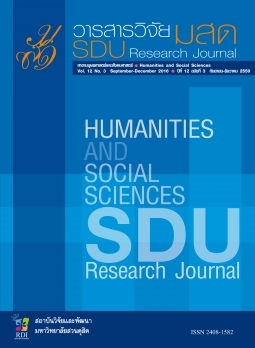การพัฒนายุทธศาสตร์การพัฒนาการท่องเที่ยวเชิงบูรณาการ : ตามแนวคิดลำปางเมืองที่ไม่หมุนตามกาลเวลา
Keywords:
Strategy Development, Strategic Tourism Development, Strategy for Integrated Tourism Development, The Concept of Lampang Where Time Stands StillAbstract
The objectives of the research are to analyze potential, readiness, and problems;
to study tourist’s trends, analyze internal and external factors involving the management
of tourism in Lampang province. In addition, this study also presents the strategies for
development of integrated tourism corresponded to be the concept of “Lampang where
time stands still” This quality research and Quantitative research. The applied tools which
would be used for compiling information are consisted of questionaired, surveys of
potential tourist attractions in the 13 districts, in-depth interviews, brainstorming
workshops, and arranging public forums in parallel with analyses of obtained quality-based
and auantity-based information. In ensuring that all the steps, scope and objectives are
met in supporting credibility and accuracy of the obtained findings, detailed analysis and
synthesis of information with regards to strategically integrated tourism management
development are applied based on the 10 strategies known as “MAUNGKHWAN Model”
represent: Strategy 1: M=Manageable Tourism for All, Strategy 2: A=Adopted Tourism
resources for Management, Strategy 3: U= Unity and Integration in Tourism Management,
Strategy 4: N=Network for Strengthening Tourism , Strategy 5: G=Government Support
Restructuring for Tourism, Strategy 6: K=Knowledge Management in Tourism, Strategy 7:
Human Resource Development for Tourism, Strategy 8: W=Whole Value Tourism
Management, Strategy 9: A=Activities Supporting Tourism for all, Strategy 10: N=Networks
Building in Community, National and International Level
References
ยืน (CBT Thailand) พ.ศ. 2559-2563.
กระทรวงการท่องเที่ยวและกีฬาแห่งประเทศไทย. (2560). ร่างแผนพัฒนาการท่องเที่ยวแห่งชาติ ฉบับที่ 2
(พ.ศ.2560 – 2564).
บุญคุ้ม บุญญโสภัต. (9 กุมภาพันธ์ 2560). สัมภาษณ์. Managing Director BKE Engineering Co.,Ltd.
พิมล พุ่มชูศรี. (14 กุมภาพันธ์ 2560). สัมภาษณ์. กรรมการผู้จัดการโรงแรมเวียงลคอร จังหวัดลำปาง.
รุ่งนภา เลิศพัชรพงศ์. (2560). การศึกษาบริบทชุมชนเพื่อการพัฒนารูปแบบการจัดการท่องเที่ยวเชิง
วัฒนธรรม กรณีศึกษา วัดพระธาตุจอมปิง จังหวัดลำปาง. วารสารสถาบันการพลศึกษา กระทรวง
การท่องเที่ยวและกีฬา, 9(3).
ศรัณย์ เลิศรักษ์มงคล. (2540). การท่องเที่ยวที่ยั่งยืนสู่การพัฒนาที่ยั่งยืน. จุลสารการท่องเที่ยว, 16(1), 12-
13.
สุวีร์ณัสญ์ โสภณศิริ. (2554). การวิเคราะห์พฤติกรรมนักท่องเที่ยว: ก้าวแรกสู่การเป็นผู้บริหารธุรกิจท่อง
เที่ยว อย่างมืออาชีพ. อินทนิล, กรุงเทพฯ.
สินธุ์ สโรบล. (2546). การท่องเที่ยวโดยชุมชน: แนวคิดและประสบการณ์พื้นที่ภาคเหนือ. นิเวศน์วัฒนธรรม
รากฐานใหม่แห่งการท่องเที่ยวโดยชุมชน. สำนักงานกองทุนสนับสนุนการวิจัย (สกว.) สำนักงาน
ภาค, กรุงเทพฯ.
อุดมศักดิ์ ศักดิ์มั่นวงศ์. (16 กุมภาพันธ์ 2560). สัมภาษณ์. ประธานสภาวัฒนธรรมจังหวัดลำปาง
Clare County Development Board. (2011). Integrated Torism Strategy for County Clare
2011 – 2014, Clare.
Doorne, Stephen. (2004). Community Integrated Tourism Development in the South Pacific
Study. Fiji : ICT Capacity Building at USP Project, The University of the South
Pacific.
Shirley, E. (1992). My travels around the world. Newton Aycliffe, UK: Heinemann.
Tourism, Culture, Arts and Heritage Belfast City Council. (2015). Belfast: Integrated Tourism
Strategy Strategy Sumary 2015-2020, Belfast.








